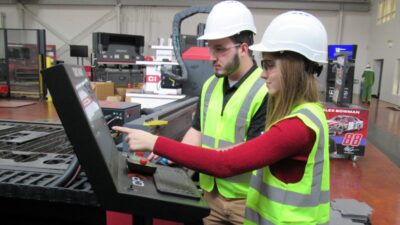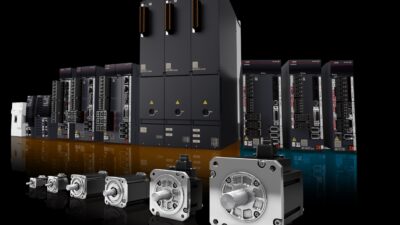The goal of enterprise-wide networking is to tie all computers, applications, printers, control systems, intelligent devices, and the Internet/intranet together to achieve real-time communications throughout the corporation.Long the network of choice at business levels of an enterprise, recent reports insist Ethernet works for industrial networking and permits a single network architectur...
KEY WORDS
Process control & instrumentation
Ethernet
Networks & Communications
Internet/intranet
Device-level networks
Fieldbus
Control architecture
Sidebars: Open networking is new alliance goal R2-D2 and C-3PO may soon exist ONLINE
The goal of enterprise-wide networking is to tie all computers, applications, printers, control systems, intelligent devices, and the Internet/intranet together to achieve real-time communications throughout the corporation.
Long the network of choice at business levels of an enterprise, recent reports insist Ethernet works for industrial networking and permits a single network architecture from boardroom to plant floor.
Understand that Ethernet alone does not deliver the entire solution. A look at the Open Systems Interconnect (OSI) model reveals seven-layers of physical media and compatible protocols are required to move data to, from, and along the physical media. The goal of network communications is realized at the application level. In-between are protocols, such as TCP (Transport Control Protocol) and IP (Internet Protocol), we have heard of, but most of us don’t know much about. Network users want those layers to remain transparent. As long as information flows in and out of applications reliably, securely, and on-time users don’t care about the underlying layers.
Reviewing the ‘old’ Ethernet helps illustrate why Ethernet is now ‘ready for prime time’ as an industrial network.
Original Ethernet implementations used a bus architecture where cable connects machine to machine and teminates on each end (See Ethernet Topologies diagram). Ethernet’s bus topology permits devices to place data packets on the network anytime a device detect silence on the line. It’s possible for two or more devices to determine it’s all right to place data on the line at the same time. When this occurs, data may collide and transmitting devices must retransmit, possibly several times before data receipt confirmation is received. The ability for multiple devices to send data simultaneously, for the data to experience collisions, and for devices to retransmit data as necessary prevents determining a time period for successful data transfers. This is known as nondeterminism and has prevented Ethernet in applications requiring real-time data exchanges.
The Open Systems Interface model is commonly used to explainthe layers of physical media and protocols necessary to achieve asuccessful network implementation.
Achieving determinism
Improvements in topology design, communication management devices, speed, and redundancy make Ethernet viable for consideration in real-time, plant floor applications.
Distributed computing technologies and client/server architectures at business levels increased the need for Ethernet to share data among machines on a predetermined basis; determinism was needed.
Eventually an Ethernet star topology was developed that manages data flow and provides determinism. In a star topology each network device resides on its own network segment and all segments are connected using a switched hub (See Ethernet Topologies diagram).
Switched hubs provide data buffering and have intelligence to know which segments have devices that want the data. Latency-introduced through data buffering-is offset by the switched hub’s ability to minimize data collisions and thus, data retransmissions.
Switched hubs can be connected to other switched hubs and data can be shared with devices in other segmented network areas. Management of data among devices that have data and those wanting data is known as the publisher/subscriber model.
Ethernet operates at 10, 100, and 1,000 million bits per second (Mb/sec) speeds. The higher two speeds frequently are referred to as Fast Ethernet and Gigabit Ethernet, respectively.
Using the same twisted-pair wiring, 10 Mb/sec installations can be upgraded to 100 Mb/sec, a significant benefit when considering installation and life-cycle costs.
Gigabit Ethernet was originally designed for fiber-optic physical media, but Cisco Systems (San Jose, Calif.) recently announced its success in operating Gigabit Ethernet on twisted-pair wiring.
Proprietary control system networks have been predominately redundant between controllers and operator interfaces, thus redundancy at the plant floor has become a de facto standard requirement.
Although the Ethernet standard used on plant floors is the same as used in office environments, its implementation is considerably different, especially when it comes to redundancy. For example, when control data must be delivered in real-time to avoid process excursions, redundant communication devices must switch in less than 300 msec. This is much faster than frequently provided by commercial network management devices.
Ethernet in industry
Ethernet is carving out a place in industrial networking at the control and I/O levels, but plant floors need industrial-strength products such as Hirschmann’s (Pine Brook, N.J.) redundancy managers or Synergetic Micro Systems (Downers Grove, Ill.) Ethernet and fieldbus cards.
Among specifications that make a network device industrial-strength is its ability to operate in 32 to 140 °F (0 to 40 °C) environments; and be powered by low-voltage sources, such as 18 to 24 V dc.
Several control system manufacturers, including Fisher-Rosemount (Austin, Tex.), ABB (Rochester, N.Y.), Foxboro (Foxboro, Mass.), and Rockwell Automation (Mayfield Heights, O.) are using Ethernet to connect controllers and operator interface devices to form control-centric Ethernet architectures.
Pushing nearer the plant floor, a few manufacturers are forming device-centric Ethernet architectures where I/O devices directly connect to an Ethernet network or are collected in Ethernet-compatible I/O data concentrators.
Many of these control- and device-centric architectures use proprietary or vendor-developed open protocols, such as ControlNet and DeviceNet, but employ Ethernet as the physical and transport mechanism, taking advantage of related economics of scale.
A few control and I/O device manufacturers have begun to offer Ethernet, TCP/IP, and HTTP protocols to deliver web capabilities to the plant floor.
Addition of web server technologies has already occurred in Schneider’s Automation Business (North Andover, Mass.) Modicon Quantum PLC (programmable logic controller), Opto 22’s (Temecula, Calif.) Snap I/O product line, Zone Automation’s (Temecula, Calif.) object-oriented device-centric servers, and Total Control’s (Melrose Park, Ill.) FactoryWeb controllers and human-machine interfaces.
Opto 22’s Snap-B3000-Net supports simultaneous, multiple protocols over the same Ethernet wire. Packaged in the same I/O data concentrator is an OPC server, and a web server, plus support for Modbus/TCP to integrate Modbus-enabled software, and packet handling for user developed visual basic, C/C+++, and ActiveX applications.
Support for these manufactures’ visions appears in a recent AMR Research (Boston, Mass.) report that describes relatively simple devices, loosely coupled, and widely distributed across the plant floor to form what AMR calls Ubiquitous Computing and Control (UCC).
AMR foresees factories densely populated with ‘built-for-purpose’ distributed web servers using embedded operating systems and applications connected to plant-floor Ethernet topologies that mimic the Internet.
A recent article in Business Week presented a similar vision, but in the consumer arena. Companies like Microsoft, Hewlett-Packard, Sony, and Philips are aggressively developing Intelligent Appliances (IA) that connect built-for-purpose consumer appliances-such as WebTV, web-aware camcorders and cameras, and WebPhones-to connect directly to the Internet. Consumer-based silicon developed for IAs will become available to manufacturers of industrial sensing and control devices, enabling cost-effective deployment of AMR’s UCC vision.
Ethernet can be implements either as a star (left) or bus (right) topology. Each haspros and cons but star topologies are most commonly recommended for plant-floorcontrol and device-level networks.
Planning for the future
Throughout the discussions of UCC and IA, Ethernet remains a common factor as a viable physical media.
The amount of Ethernet in your future depends on application requirements, including how devices receive power and if intrinsic safety is needed. Ethernet is not well suited for either of those requirements, but don’t dismiss Ethernet as being viable on the plant floor based on dated perceptions and information. New Ethernet technologies appear almost daily. Today’s Ethernet has about as much resemblance to 1980s Ethernet as today’s personal computers have to computers of that era.
The message to users struggling with fieldbus and plant floor networking decisions is, deploy Ethernet as near to the plant floor as practical. In areas where a fieldbus solution makes sense, design a topology and use wiring that can support Ethernet in the future. This approach is most likely to future-proof the plant’s network architecture.
Open networking is new alliance goal
Hoping to establish an open industrial networking protocol that acts like the Internet, the Industrial Automation Open Networking Alliance (IAONA) held its first meeting during ISA/98.
Using the OSI model as a basis for discussion, attendees acknowledged Internet clients and servers use different operating systems, and applications connect and share information everyday using TCP/IP over Ethernet. Whether it’s the best solution is irrelevant; the Internet is an open network. It has been defined, product has been built, and it has uncountable hours of testing. IANOA’s message, ‘Stop fighting the Internet, accept and embrace it.’
Arguments that browsers are not eloquent interfaces are true, but they are recognizable, comfortable, and will continue to evolve. As Internet use increases, developers are challenged to create new ways to present information. Java, ActiveX, and HTML (Hypertext Markup Language) will be joined by SGML (Standardized General Markup Language), and XML (eXtensionable Markup Language), plus others.
Focus on the potential
IAONA members claim design requirements, marketing stratagies, and time-to-market would be different if industrial product manufacturers understood each device was going to be connected to networks that mimicked Internet FTP servers.
Issues associated with interoperability, operating systems, setup and installation, revision control, data transfer, alerts and warnings, status monitoring, and debugging and maintenance would disappear or be minimized. For example, ‘on-site’ vendor device support could be provided through a secure login.
Revision control management can be all but eliminated. With the Internet, users are not required to keep pace with upgrades occurring to Internet servers and service providers.
Warnings and alerts can be automatically processed through e-mail servers to computers, cell phones, pagers, etc. Messages can contain data and be in the language most clear to the recipient. Response requirements can be established that automatically escalate notifications until a response is received.
According to Mike Romanies, NETsilicon (Waltham, Mass.), an IAONA alliance member, ‘If IAONA’s solution results in network communication chips embedded in devices such as vending machines, gas pumps, custody transfer utility meters, machine and process controllers, transmitters, home security systems, and televisions, the cost to connect a device to the network would be $10 to $15 U.S. dollars.’
For more information about IAONA’s activities or to participate in an ‘Issues survey’, visit
R2-D2 and C-3PO may soon exist
In the popular ‘Star Wars’ movies, two computers, R2-D2 and C-3PO, collaborated to solve problems and provide information to the human heroes battling ‘forces of the dark side.’ In the near future, the World Wide Web (www) will permit similar collaboration.
The most successful network developed is the Internet. The protocol used on the Internet by the www is Hypertext Transport Protocol (HTTP).
When HTTP was originally designed there was no way to predict how much web-related traffic would occupy the Internet. A 1997 release of HTTP 1.1 ‘tweaked’ performance of this hard-working protocol, but HTTP-NG (Next Generation) is being developed to transform www into an intelligent web. HTTP-NG embodies a more extensible architecture and blend of HTTP 1.1 with features found in DCOM (distributed common object module) and CORBA (common object request broker architecture) to form machine-readable formats and permit machines to collaborate across the www without human intervention.
Full implementations of HTTP-NG are still a long way off, but HTTP-NG will undoubtedly find its way to the plant floor where real versions of R2-D2 and C-3PO await.
ONLINE
Control Engineering Online Extra: comprehensive list of networking terms. Also at
Mar. ’99, ‘Network Hardware: Making the Connection’
Dec. ’98, ‘Ethernet Edges toward Process Control’
Sep. ’98, ‘Networked I/O Stratagies Connect’
Jan. ’98, ‘Connect to the Benefits of Digital Industrial Networks’



